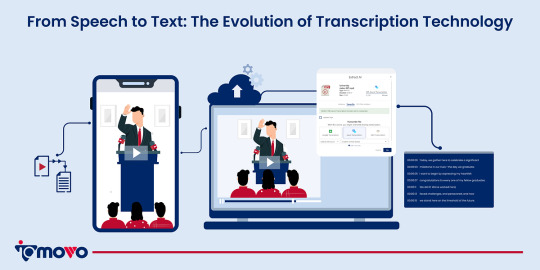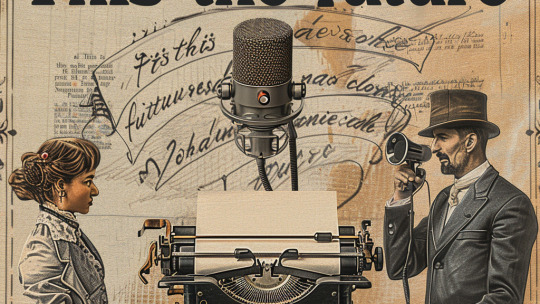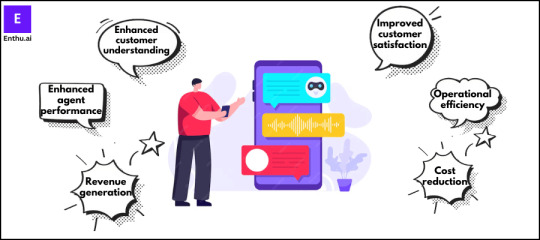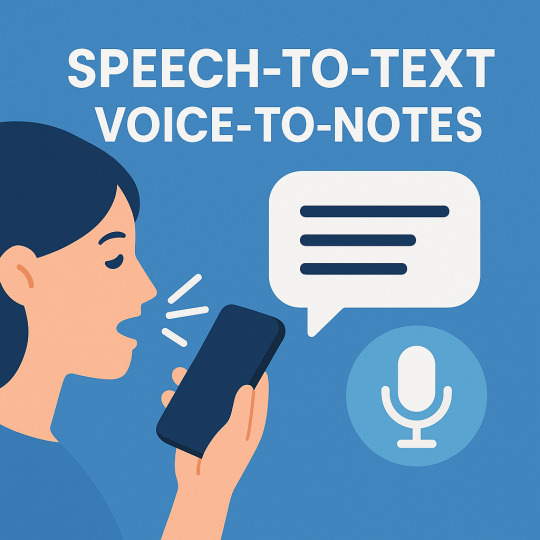#VoiceToNote
Explore tagged Tumblr posts
Text
Can Speech-to-Text Replace Typing in the Future?
Can Speech-to-Text Replace Typing in the Future?

We are adapting our approach to using technology. Voice assistants, screens you can touch, and content created by AI are some of the latest ways users communicate. One of the most exciting developments is STT technology, which changes what people speak into written text instantly. You can use it without fumbling; it's quick, and more and more, it's precise. Yet, we need to ask: Will speech-to-text eventually take typing's place?
There isn't a simple answer. No matter how powerful speech-to-text is, it depends on certain technological, social, and contextual factors to become a regular way we communicate online. This piece examines what speech-to-text offers now, what it cannot do, and argues whether it is ready to take over typing.
Speech-to-Text Technology Through the Years

The technology for changing speech to words has been around for a while. Back in the 1950s, the Audrey system at Bell Labs was a pioneer in voice recognition, allowing it to pick out sets of digits. Now, Google Dictation, Apple's Siri, Microsoft Dictate and Whisper, and Dragon NaturallySpeaking can transcribe speech with more than 95% accuracy if conditions are optimal.
Various improvements in technology have supported the growth we saw.
The use of transformers in neural networks has led to a huge advance in the accuracy of speech recognition.
Because of Big Data, systems can analyze recordings of many accents, dialects, and ways people speak to improve their performance.
Thanks to the cloud, real-time processing is both quicker and has a wider range of possibilities, even on small handheld devices.
With NLP, systems now have better context, thanks to which they can distinguish homophones and anticipate punctuation much more effectively.
Because of these innovations, using speech-to-text is now more practical than it used to be just 10 years ago. Is it possible to delete all typing without losing anything?
Benefits of Speech-to-Text More Than Typing

1. How fast tasks are completed
We tend to speak faster than we can type words. Every day, people can:
Try to complete about 60 wpm.
Recite your text somewhere between 120 and 160 words per minute while recording.
Because STT transcribes much faster, it can greatly boost productivity for writers, journalists, doctors, and lawyers who deal with a lot of text each day.
2. Accessibility
With speech-to-text, individuals can access information more easily.
For example, diseases such as carpal tunnel and paralysis.
Visual impairments.
Conditions such as dyslexia create learning difficulties.
STT is a breakthrough for these users within both professional and educational settings.
3. Hands-Free Convenience
Voice recognition works best when it's not practical to type.
Driving to school or commuting by any mode.
Making dinner in the kitchen or dividing my attention between different things.
In this era, people use wearable devices (such as smartwatches and AR/VR).
It makes life easier in situations like industry or medicine, where you do other things with your hands.
Problems and Obstacles
Regardless of how speech-to-text helps, many problems prevent it from being used as a total replacement for typing.
1. How well organizations work outside the lab
While it works fine in quiet places where the speaker is easy to hear, STS experiences difficulties when:
Background noise.
Appealing mannerisms or ways of speaking.
Mumbling.
Technical jargon.
Even a few incorrect words in every 100 (5% usually) can disrupt the way documents are communicated in a workplace.
2. Fears about privacy and security
It isn't always safe or convenient to say our passwords out loud.
Since noise and eavesdropping happen in open office spaces, employees avoid speaking out loud.
You should type your passwords and financial details, not share them with others.
People are concerned about being watched and having their information shared with voice recognition devices.
3. Problems with Accuracy
It's great for writing a draft but less suitable if you want to edit your work.
A keyboard and mouse make it simpler to change just one word or move an entire sentence.
These commands, such as "delete the last paragraph" and "move this section," are difficult to use and frequently cause confusion.
Many writers, coders, and editors continue to benefit from the accuracy and control typing provides.
4. Standards and expectations of a society
It's considered more appropriate to type rather than talk in this situation:
Instead of talking, typing allows a person to communicate less disturbingly in a group.
People are likely to think more about what to say before speaking, which can shape their online content in some way.
Moving towards voice interaction means people and companies need to change their ways of thinking just as much as their technologies.
Situations Where Using Speech-to-Text is Better Than Typing
There are times when speech-to-text could be used as the main way to enter information:
The efficient use of STT by Agents makes it possible to document and authorize calls in the CRM right away.
Doctors are using voice dictation to record information into patient files using Nuance Dragon Medical.
Surveyors, engineers, and researchers can collect information right at the site without the need for a keyboard.
STT helps students with learning disabilities to finish their assignments more easily.
Voice instructions turn those types of tasks into truly different experiences.
A Combination of Approaches Is Likely for the Future
Probably, the most common outcome will be a hybrid of speech-to-text and typing.
For example:
You can write emails or documents with your voice using this app.
Using only the keyboard, edit, format, and complete the project as needed.
If you are using a phone, speak into it using STT, but on a computer, type your text.
There are already examples of software making this change. All three—Google Docs,
Microsoft Word and Apple's macOS have built-in voice typing that goes well with traditional keyboard and mouse typing.
Users can now talk to their AI assistants much like they'd talk to a person, thanks to voice input features like those used by ChatGPT.
How Should the Replacement be Achieved?
Speech-to-text will have to fulfill these conditions if it is to replace typing.
Due to improved accuracy, it performs best in loud, complicated, or cluttered locations.
Powerful Editing Features: Offering the option to change sentences just by speaking.
Designed for All Users: No matter what language, device, or skillset you have.
Offline STT and sending encrypted voice information help support your privacy.
Participating in conversations in groups or shared spaces with voice commands should cause no concern for anyone.
For as long as these goals aren't reached, speech recognition will stay a useful tool rather than one that completely replaces the need for writing.
Overall: Boosting, Not Eliminating
Speech-to-text technology represents one of the largest advances in human-computer interaction today. Its ability to reduce communication delays, provide easier access, and support the simultaneous performance of many tasks gives it great value for various sectors. Still, we will need to type for a while longer.
Instead of taking over typing, STT will boost the process, allowing people to select the style that makes the most sense in a particular situation. You could find that dictating your words in a quiet place helps you go faster. Even when working on a contract or website, the keyboard is the main tool you'll use.
In time, being productive will likely depend on when to talk and when to type rather than just how fast someone types.
0 notes
Text
Why Voice-to-text is the future of note-taking
Why Voice-to-text is the future of note-taking
Taking notes used to be a simple affair: a pen, a paper, and some highlighter if you felt fancy. Comparatively, fast forward to now and we’ve got laptops, smartphones, smart pens and even AI assistants ready to take down things. But particularly on technology is quietly (or rather, vocally) changing this game— voice-to-text.
If you have ever dictated or talked to your phone to send a message while you are cooking, you’ve already experienced the convenience and benefit of voice-to-text note-taking. Voice-to-text note-taking is not just a casual helper— nowadays it's becoming a primary method of taking notes for many people out there, and it might be a future for many of us too.
Now, let us dive into some reasons why voice-to-text is the future of note-taking:

1. Speed and Efficiency — It’s Not Even Close
We all know the fact and agree with it too that speaking is faster than typing. On average, many people type only 40 words per minute (wpm). Meanwhile, we can speak at a speed of 125 to 150 words per minute (wpm). That’s no doubt 3 times faster. Imagine taking notes, meeting minutes, or brainstorming ideas at that pace.
Accuracy totally depends upon the software and environment, but these modern and advanced voice recognition systems have really gotten it covered, thanks to AI. Services like Voicenotes.ai, Google voice typing, and other built-in tools for iPhones and Androids now give clear and impressively accurate transcribed notes, even picking up punctuation and differentiating between speakers.
This means less time scribbling and typing on a keyboard and actually more time thinking.
2. Multitasking Made Possible:
We all know that while typing, we have to stay, wait, and concentrate completely on the work. But voice-to-text typing has made multitasking possible for us; that’s a big deal. Now, we don’t have to put our entire time and focus on typing lengthy emails, business documents, and messages. We can simply talk in front of our phone, and within seconds, we receive our transcribed text.
Since it's a hands-free experience, it provides opportunities for those who are not able to type efficiently — whether due to some kind of disability, repetitive strain injuries like carpal tunnel, or temporary conditions like a broken wrist. Many advocates these days use these latest technologies over last decade's patterns.
It enables people to communicate with technology on their own terms, without being limited by any physical disability. That’s more than a convenience — it’s the way we empower people.
3. The Rise Of Natural Processing Language (NPL)
Natural Language processing has come a long way. It's not just about transcribing your words anymore; it's about understanding the context.
Many apps recognize different speakers and organize them with labels. AI Transcriptions can understand key themes, call ro action and many other things. In short, the software itself starts to think with us.
This tool not only records your voice and converts it into text but also provides an assistant for helping you and making Sense of the notes they have prepared for you. As NLPs are starting to develop, we're more likely to see more advanced assistance and intelligent summaries.
4. The Mobile World Demands It
Our devices are increasingly mobile. Laptops are shrinking, smartphones are getting smarter, and watches are becoming mini communications hubs on our wrists. Voice-to-text is a natural fit For these shift. Typing on small screens is not ideal, but speaking? It's easy.
Think about journaling On the go, with a run in the morning, or making a shopping list while cooking. With the rise In voice-to-text note-taking, we are able to match.
Adding on to that, with the growing industry of AI assistants like Siri, Alexa, and Google Assistant, you can see why Voice-to-text typing is becoming the norm these days. Then the ability to sync these notes across different platforms— from your phone to your laptop to your tablet— makes everything seamless and connected.
5. It Encourages Better Thinking (Sometimes)
There's an interesting psychology Twist here. When we talk, we tend to think freely. There's less pressure to edit or to be perfect. This can be great for brainstorming, journaling and capturing fleeting ideas. Many writer's say that they have “Thinking Fingers” — but it turns out your voice can be better for channeling your thoughts.
Many creatives use voice memos to capture their thoughts on the fly. Authors dictate their books, entrepreneurs record their business books, and Podcasters Podcast their thoughts vocally.
Of course, this doesn't mean voice-to-text has taken over the precision of handwritten notes or careful outlines. But it offers a different kind of productivity— one that's fluid and spontaneous.
6. A Learning Tool for all Ages
Another underrated benefit of voice-to-text is in the role of education and learning. For young children learning to write or non-native speakers learning English, voice dictation can serve as both an aid and a pronunciation tool.
It's also used in many ESL classrooms for students to associate the spoken English language with written words.
Older adults are also opting for voice-to-text as an alternative to typing. It's intuitive and doesn't require tech savviness to use. In fact, digital literacy becomes more essential; tools like these help bridge generational gaps in technology use.

A Few Caveats, Because Let’s Be Real
No, voice-to-text isn't perfect. Background noise can be a pain, and privacy is always a concern—especially if you’re dictating sensitive information. Some people feel awkward talking to their devices in public, and others still prefer the tactile satisfaction of pen on paper (nothing wrong with that).
Also, let’s face it, transcription software can still get things hilariously wrong sometimes. I once dictated "send notes to Kevin about the project timeline" and got back "send goats to heaven about the object skyline." Close enough?
But even with its quirks, the benefits are too strong to ignore. Voice-to-text is catching up fast—and it’s only getting better.
Final Thoughts: Speak Your Notes into Existence
The future of note-taking isn’t just faster—it’s smarter, more intuitive, and more inclusive. Voice-to-text is at the center of that transformation.
Whether you’re a student, a professional, a creator, or someone who just needs a better way to remember things, now is a great time to give your voice a shot at doing the writing.
Who knows—your best ideas might already be floating around in your head. It’s time to speak them into existence.
0 notes
Text
Best Speech-to-Text Apps of 2025
Converting voice recordings into written text has become a valuable time-saver for professionals, students, and creators alike. Whether capturing meeting notes, brainstorming ideas, or recording interviews, having a reliable transcription tool can be a lifesaver. However, there are many options out there. The article talks about free speech-to-text apps in 2025 that can help you turn your spoken words into clear text effortlessly.
What is the meaning of the Speech-to-Text app?
This app is a tool that listens to what you say and turns spoken words into written text. Instead of typing on a keyboard, you can just talk, and the app will write it down for you. These apps help take notes, write messages, and create documents quickly using your voice. This app is handy for people who want to save time or have trouble typing due to an accident or disability.

What should you look for in a Speech-to-Text app?
Below are some features that you should consider before choosing a Speech-to-Text:
Accuracy: How well does the app understand different accents, tones or background noise?
Language Support: Does it support regional or multiple languages?
Offline: Does the app work without Internet?
Speed: How fast does it convert voice to text?
Export options: Can you easily save, edit, or share your transcripts?
Privacy and security: Does it keep your recordings and transcripts private?
Understanding what speech-to-text apps do makes it easier to choose the right one, so let’s explore some of the tools that can convert your voice into text effortlessly.
VoiceToNotes
VoiceToNotes is a free and easy-to-use tool that quickly turns your spoken words into written text. This app is designed in such a way that makes your daily tasks simple, as the web-based platform uses advanced voice recognition to capture what you have said and convert it into readable notes. It works straight from your browser, making it ideal for creating quick lists, short notes, or even longer documents without needing to type.
Unique Features of VoiceToNotes
No Hidden charges and 100% free to use.
Clean and user-friendly layout, perfect for beginners.
Works well with different types of accents.
Provides Accurate Transcription.
Although there are some things that we have to keep in mind such as, the app requires a stable internet connection to function. It may have trouble with very strong regional accents and only supports plain text, such as no bold, italics, or other formatting options. As a user, you can download the app through the Apple app and Google play store.
Google Recorder & Docs Voice Typing
Google offers users two powerful tools: Google Recorder for Android devices and Voice Typing in Google Docs on Desktop. Both tools use Google’s advanced voice recognition technology to deliver accurate, real-time transcription. Moreover, Google Recorder even works offline on some devices, and users can search recorded audio by keywords.
Furthermore, Google Docs Voice Typing allows users to dictate directly into a document, making it ideal for long-form writing or note-taking. With a clean interface, multi-language support, and easy integration with Google Drive, these tools are reliable choices for anyone looking to transcribe voice to text quickly.
Unique Features of Google Recorder & Docs Voice
Provides Real-time transcription with high accuracy.
Integration with Google Drive for easy sharing.
Supports Multiple languages.
Google Recorder can be downloaded from the Google Play Store and works offline on Pixel devices.
Otter.ai
It is a powerful speech-to-text app that is trusted by professionals, students, and content creators for its high-quality transcription abilities. One of the best thing about this app is that can transcribe conversations in real time, identify different speakers in voice recordings, and add timestamps, making it ideal for interviews, meetings, and lectures.
Its free version gives users up to 300 minutes of transcription each month, which is often enough for daily tasks. Otter.ai also lets you upload pre-recorded audio or video files and provides editable, searchable transcripts. Moreover, it has a user-friendly design and cloud syncing, making it a great tool for organized voice-to-text conversion.
Unique Features of Otter.ai
Provides the ability to import audio and video files.
Sync with Zoom and Google Meet.
Allows editing and keyword searching in transcripts.
Users can download it from the Google Play and Apple App stores.
Provides users with 300 minutes per month and a 30-minute cap per recording.
Microsoft Dictate
Microsoft Dictate is a speech-to-text feature that is built right into Microsoft Office apps like Word, Outlook, and Powerpoint making it a great choice for users already familiar with the Microsoft ecosystem. It allows you to dictate text directly into your documents or emails with good accuracy and supports multiple languages.
It also understands basic voice commands, and since it is already included in Microsoft 365 and Windows 11, there’s no need for extra downloads. However, it needs a stable internet connection.
Unique Features of Microsoft Dictate
It is seamlessly integrated with Microsoft Office.
Real-time dictation with live text output.
Supports multiple languages and voice commands.
No separate download is needed if you have Windows 11 or Microsoft 365.
Speechnotes
It is a simple and efficient speech-to-text app widely used by Android users who prefer a clean and hassle-free interface. It’s designed for quick note-taking, making it ideal for jotting down ideas, to-do lists, or even longer text without distractions. The app supports voice commands for punctuation, saves notes automatically, and allows easy export to email or Google Drive.
Even though the free version includes some ads, it still offers a solid and user-friendly option experience for those who want to convert their voice recording into text quickly. Another disadvantage is the iOS version gives limited options.

Unique Features of Speechnotes
It has an easy interface with one-tap recording.
Listens to punctuation commands.
Auto-saving notes.
Export to Google Drive or email.
It is available on the Google Play Store.
Conclusion
To wrap it up, the speech-to-text apps highlighted in this article are tools that can help you turn your voice into text with ease in 2025. Whether you're looking for something simple for quick notes or a more advanced solution for meetings and lectures, there's an app to fit your needs. By choosing the right app, you can save time, boost your productivity, and make your work more efficient, all while enjoying the convenience of voice-to-text technology.
FAQ’s
Are these apps really free?
Yes. All the apps mentioned here are free. However, some of the apps might offer premium upgrades with more transcription time, extra features, or better cloud storage.
Can I use them to record interviews or lectures?
Yes. You can use these tools to record interviews or lectures. However, some free plans limit how long you can record. For example, Otter.ai has a 30-minute cap per file in the free version. For longer recordings, try using apps with no limits, such as Speechnotes.
Do these apps support other languages besides English?
Yes, most apps support multiple languages. Google and Microsoft lead in multilingual capabilities, while others like Otter.ai and Speechnotes also support common languages like Spanish, French, and German.
Are my voice recordings and transcriptions private?
Even though most apps use cloud processing, which may store your data temporarily. However, you have to check each app’s privacy policy. Furthermore, Google and Microsoft follow strong security standards, while apps like Otter.ai offer encryption and user-controlled privacy settings.
#speech to text#voice to text#ai productivity#2025 tech#voice notes#digital tools#ai writing assistant#tech for creators
0 notes